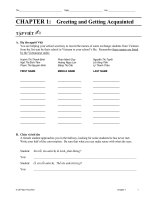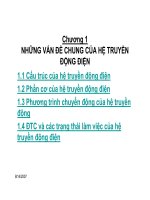Tài liệu Chapter 1: Measurement docx
Bạn đang xem bản rút gọn của tài liệu. Xem và tải ngay bản đầy đủ của tài liệu tại đây (463.58 KB, 9 trang )
Chapter 1
Measurement
In this chapter we will explore the following concepts:
1. Measurement of a physical parameter
2. Units, Systems of units
3. Basic Units in Mechanics
4. Changing units
5. Significant figures
(1-1)
In Physics we carry out experiments in which we measure physical
parameters. We then try to deduce the relationship between the measured
quantities. We usually express this relationship in the form of a mathematical
equation which we call the “physical law” that describes the phenomenon
under study. A familiar example is Ohm’s law. The experiment in this case
consists of measuring the electric voltage difference V applied across a
conductor and the resulting electric current I that flows through the conductor
If we plot I versus V we get a straight line. This is expressed in the form:
The equation is known as: “Ohm’s Law”
R is known as the “resistance” of the conductor
Constant
V
R
I
= =
(1-2)
Assume that you step on your bathroom scale and that it reads 120
The number alone is meaningless. It must be accompanied by the units
120 lb is a very different reading from 120 kg!
Conclusion: For every physical parameter we will need the appropriate units
i.e. a standard by which we carry out the measurement by comparison to the
standard. Does this mean that we have to define units for all parameters?
The answer is no. In mechanics we need to define
only three parameters:
These parameters are: Length , Time, and Mass
They are known as: base quantities
Note: For the rest of the non-mechanical parameters we need to define only
one more unit, that of the electric current
In this book we use the International System of Units (SI)
In this system the units for the base quantities are:
Parameter Unit Name Symbol
Length meter m
Time second s
Mass kilogram kg
(1-3)
A
C
B
earth
equator
The meter
In 1792 the meter was defined to be one ten-millionth
of the distance from the north pole to the equator.
For practical reasons the meter was later defined as
the distance between two fine lines on a standard
meter bar made of platinum-iridium.
Since 1983 the meter is defined as the length
traveled by light in vacuum during the time
interval of 1/299792458 of a second. The reason
why this definition was adapted was that the
measurement of the speed of light had become
extremely precise
7
1 m
10
AB
≡
(1-4)
The Second
Initially the second was defined as follows:
The problem with this definition is that the length of the day is not constant as
is shown in the figure. For this reason since 1967 the second is defined as
the time taken by 9192631770 light oscillations of a particular
wavelength emitted by a cesium-133 atom. This definition is so precise
that it would take two cesium clocks 6000 years before their readings would
differ more than 1 second.
1
1 second
24 60 60
of the time it takes the earth
to complete a full rotation
about its axis
≡
× ×
(1-5)









